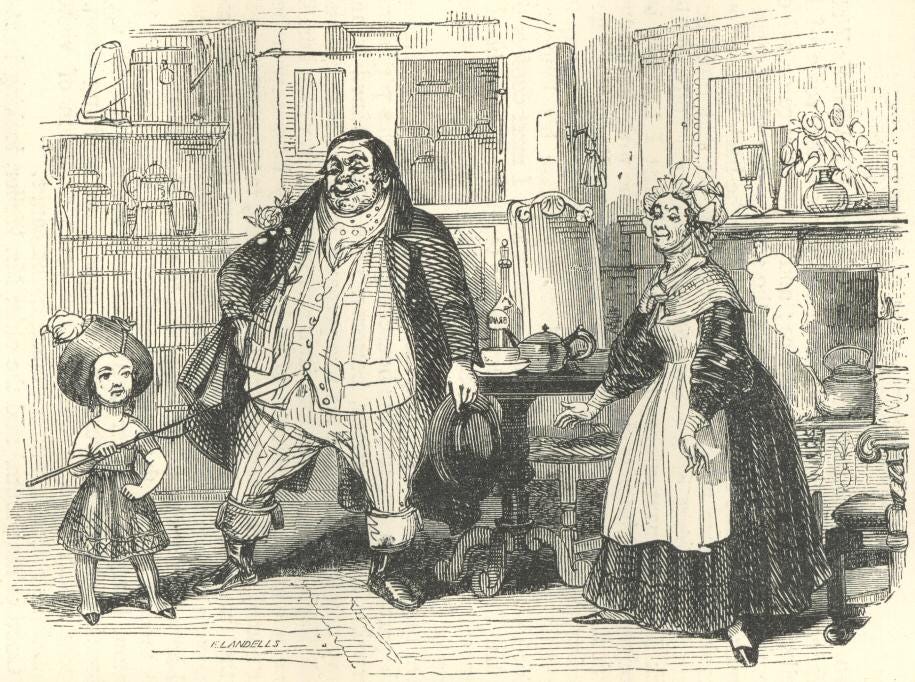Read-along – The Old Curiosity Shop (9 of 18)
Chapters 6-8 – and Master Humphrey, from His Clock-Side in the Chimney Corner
Dear Old Curiosity Shoppers,
Since we last met, we’ve read the tenth and eleventh issues of Master Humphrey’s Clock, which featured the next three chapters of The Old Curiosity Shop and the last instalment of the Master Humphrey narrative before we see it disappear entirely.
Let me know what you thought!
In a month’s time, on 18 July, we’ll discuss Chapters 9-16.
From this point on, Dickens published two chapters of The Old Curiosity Shop in each issue of Master Humphrey’s Clock. If you want to keep track of the next weekly instalments, they were as follows:
No.12 (20 June) Chapters 9-10
No.13 (27 June) Chapters 11-12
No.14 (4 July) Chapters 13-14
No.15 (11 July) Chapters 15-16
In the final episode of the frame narrative, Master Humphrey is walking in his garden when he overhears Mr. Weller (and his grandson Tony) visiting the housekeeper.
Mr Weller alternates between indulging his grandson and upbraiding him. Eventually his admiration wins through and he encourages Tony to put on his stage-drunk performance: Tony smokes imaginary pipes, drinks visionary beer and pretends to be intoxicated. This routine throws Mr Weller ‘into ecstasies’.
As we say goodbye to the Wellers, we see them moving away and performing the drunk act as they go:
When he took his leave he carried the child, like some rare and astonishing curiosity, first to the barber’s house and afterwards to the tobacconist’s, at each of which places he repeated his performances with the utmost effect to applauding and delighted audiences.
This reminds me of an early passage from John Forster’s Life of Dickens, in which he describes Dickens’s childhood in Chatham, Kent. It seems Dickens’s father was as proud of young Charles as Mr Weller is of Tony:
He [Dickens] told a story offhand so well, and sang small comic songs so especially well, that he used to be elevated on chairs and tables, both at home and abroad, for more effective display of these talents.
Forster goes on to say:
When he first told me of this, at one of the Twelfth-night parties on his eldest son’s birthday, he said he never recalled it that his own shrill little voice of childhood did not again tingle in his ears, and he blushed to think what a horrible little nuisance he must have been to many unoffending grown-up people who were called upon to admire him.
One venue where Dickens is said to have sung sea shanties on the tables was the Mitre Inn in Chatham (now Primark).
In ‘The Holly-Tree’ (1855), which Dickens wrote for Household Words, he recalls the Mitre:
It was the Inn where friends used to put up, and where we used to go to see parents, and to have salmon and fowls, and be tipped. It had an ecclesiastical sign,—the Mitre,—and a bar that seemed to be the next best thing to a bishopric, it was so snug. I loved the landlord’s youngest daughter to distraction,—but let that pass.
I look forward to reading the next eight chapters of The Old Curiosity Shop and discussing them in a month’s time, on Friday 18 July!
Here are links to our previous Old Curiosity Shop posts:
The Schedule (14 March 2025)
Charles Dickens (28 March)
0. Forster’s Life of Dickens (4 April)
1. Master Humphrey’s Clock No.1 – and Gog and Magog (11 April)
2. Master Humphrey’s Clock No.2 – and G. K. Chesterton (18 April)
3. Master Humphrey’s Clock No.3 – and Edgar Allan Poe (25 April)
4. Master Humphrey’s Clock No.4 – and the Old Curiosity Shop (2 May)
6. Master Humphrey’s Clock No.6 – and St. Dunstan-in-the-West (16 May)
7. Master Humphrey’s Clock No.7 – and Jack Bamber’s tale (23 May)
And if you’re not reading The Old Curiosity Shop with us, remember you can choose to opt out of our conversation. Just follow this link to your settings and, under Notifications, slide the toggle next to ‘The Old Curiosity Shop’. A grey toggle means you will not receive emails relating to this title.








This is making me feel more than a bit uncomfortable - especially knowing some of the theories about Dickens and Ellen Ternan (older than Nell, but still very young). I think where 21st Century sensitivities come into it is that it feels as if it is being presented as comic when it's anything but. I think it's the context that is so disturbing: Quilp seeing off Mrs Quilp and Fred basically selling his sister. Nell's vulnerability - we all know what to expect, don't we? Hearts of stone at the ready - is also a factor. Older men and younger women can be a source of comedy ('Don Pasquale' and its earlier form 'The Silent Woman' come to mind), but older men and young girls just feels creepy.
The ball, though, is a delight. The petty snobbery of not having country dances, Dick Swiveller dancing like a forerunner of John Travolta and Mrs Wackles' response to the young girls laughing - this is the humour I can sign up to.
Dick Swiveller's map of London made me smile. It feels like he will grow into Mr Micawber, if all goes well. At the moment, he feels like a likeable rogue - but that could all change.
And we have the element of mystery: what is the grandfather doing out at night? Gambling? Or what? It's definitely a page-turner, so limiting myself to two chapters a week will be a challenge (especially in this weather).
Quilp’s character is such a strange one. It’s like Dickens wants to give him no excuses - he is just a “villain”. I also find it interesting that the contents of the letter are never shared - probably because that is part of the “mystery”.